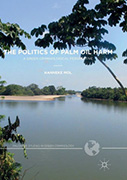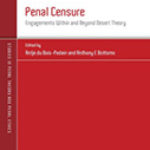The Politics Of Palm Oil Harm: A Green Criminological Perspective

Author: Hanneke Mol
Publisher: London: Palgrave MacMillan, 2017. 245p.
Reviewer: Mark Ungar | July 2019
The astronomical rise of palm oil as one of the world’s most extensive crops – it is now an ingredient in half of all supermarket products and accounts for about a third of all vegetable oil produced globally – has led to an equally huge need to understand and address its wide-ranging impacts. Hanneke Mol takes a giant step toward that goal. Building in-depth analysis from extensive empirical work in the case study of Colombia, this book is essential reading for any understanding of one of the biggest challenges to the world’s ecological sustainability.
She begins with an introduction to palm oil, describing the extent of its production while explaining the many advantages and harms attributed to it. By far the highest yielding oil crop requiring the least amount of fertilizer and land (10 times less than soybean, for example), the land-use change of degraded land to oil palm can increase carbon storage. More broadly, palm oil “plays a crucial role in meeting the rise of global demand for food; supports affordable food prices; contributes to poverty alleviation by generating employment; stimulates rural development,” and other advantages. But, as Mol demonstrates throughout her book, such advantages are far outweighed by palm oil’s wide ecological, economic, social, and cultural damages. In taking the broader view that incorporates all of these dimensions, Mol creates an analytical framework steeped in green criminology’s focus on the ravages of extractivism and its global harms, even when technically legal. To do so, she adopts “an approach to harm explicitly connected to a view on power” in order to enable the study “to interrogate the mechanisms and relations of power that invest practices and discourses of harm” (page 14). Analysis “centered on social harm,” she asserts, can “challenge existing power configurations and structural inequalities” (page 49). Building on treadmill of production theory, which sees the extraction of raw materials and their conversion into commodities as the basis of environmental destruction, she looks expansively at the “cultural, environmental, and social impacts of the Agro industrial production level of palm oil” (page 146). Chapter Two in particular develops this framework well by delving into humans’ relationship with the ecosystem, the expansionary logic of capitalism, and how the distinction between crime and harm is a socially-constructed legality.
She draws out and describes these impacts in detail through fieldwork in coastal Colombia, a tropical and poor area that is the heart of palm oil agribusiness. Working in the municipality of Tumaco, located in the south Pacific Coast department (province) of Nariño, she focuses on the people of the area – Colombians of African descent who have been marginalized and oppressed since colonial times. This focus allows the book to “provide an encompassing account of the different perceptions, practices and lived experiences of harm in the context of palm oil production” by showing how “on-the-ground practices, discourses and relations” around that production reflect “the broader structures of power and control” (page 53). Those structures and relations, though, are not always clear cut. One of the complexities she sees is the “political coexistence of what seemed to be a rather substantial support for the palm oil industry by small growers in the strong rejection of the industry by local critics within the same population” (page 13). There is great division within the population, in fact, since small growers account for nearly 40% of local palm oil production (page 83).
The book’s extensive assessment of economics brings together the larger themes of dispossession, ecology, and power. She describes the practices to open up the land for mass cultivation, which went further than simply economic claims and employed discourses that “seek to reconfigure existing social relations, ways of being, and human environment interactions” (page 123). Much of that approach is centered on claims that agro-industry is “the only viable way to alleviate poverty and improve local standards of living” (page 128) in these “undeveloped” (page 127) areas, which are also presented as “disorderly and governed” (page 211). Oil palm is also cast as “alleviating pressure on surrounding forest ecosystems” (page 129), when of course they destroy natural habitats and biodiversity. The claim that oil palm plantations are like forests is repeated so often that they become part of the mantra that they put the land to “productive use” (page 145) which implies that the lack of plantations is unproductive. An accompany charge, both indirect and direct, is that the local population lacks the necessary “entrepreneurial mentality” to escape from poverty and underdevelopment (page 177). The book also delves into the increasing debate over certification. In particular, she points out that the Roundtable on Sustainable Palm Oil (RSPO) may just be another form of greenwashing (page 171). In fact, recent studies in Indonesia and Malaysia, the source of 80% of the world’s palm oil, indicate that sustainably harvested palm was no better for the environment then uncertified palm.
Through extensive interviews with local farmers (page 113), Mol then delves deeper into several issues that demonstrate the depth of the divide between oil palm and the very meaning of land, sustainability, culture, and social relations in the local communities that it dominates. One such issue is the law. In a pattern seen throughout Latin America, laws meant to protect areas are gradually eroded. In Colombia, 1959’s Law Two declared the entire Pacific region a forest reserve. Increasingly, though, “areas that were considered suitable for agriculture or livestock ventures were withdrawn from the forest reserve so that concessions could be granted for” agroindustrial use. Such concessions are perfectly legal, done through legal channels – underscoring green criminology’s critique of the law’s weakness. Reserves, in fact, are probably the clearest legal protection that can be provided. But even in countries with strong and extensive reserve systems, such as Ecuador and Bolivia, even such designation is no guarantee – both countries are drilling and paving their own reserves. Another legal erosion is through land titles, which are enshrined as “inalienable, imprescriptable, and in inembargable” in Colombia’s 1991 Constitution and backed by the nation’s strong judiciary. As Mol explains, though, “when neoliberal development models run up against the legal limits set by the collective land titles granted to Afro Colombian indigenous peoples such ‘obstacles’ are often softly violently overcome” (page 63). Even the strongest laws cannot withstand the onslaught of mining, “oil extraction, large-scale cattle ranching, rice fields, and vast plantations of oil palm” (page 79). Another of Latin America’s fundamental guarantees of environmental protection in Latin America is required consent from affected communities of a major economic activity. But Mol shows that manipulation of such consent, such as deceiving a group or negotiating with a small fraction, remains a very common tactic.
Another common theme in the book is violence. Mol seeks to “disentangle the complex and varied linkages that exist in practice and in discourse between the harms and crimes endured by local populations and environments, the operations of the palm oil industry, and the presence of legal and illegal arm actors and illicit economic activity in the region” (page 92). Such an endeavor further underscores the deeper patterns of power and the deceptive discourse used to disguise them. In Colombia, criticisms of palm oil are often dismissed “as an expression of subversive sympathies and political ideology” (page 93). Another effective use of discourse was the “depictions of frontiers as untamed and lawless spaces” (page 124), with an absent state. Of course, such areas were never actually empty or lawless. In fact, many of threats, displacements and disappearances resulted from resistance to palm oil projects (page 158). But amid the ongoing political violence in the region and throughout Colombia – involving the FARC, organized crime networks known as Bacrim – palm oil companies positioned themselves as stabilizers. The “view that corporations play a decisive role in creating the social and economic infrastructure needed for a way out of the violence and conflict” was one that “was widely shared” among corporate and political officials alike (page 99).
In its final empirical chapter, the book describes a devastating epidemic of bud rot that began in 2005 and reach epidemic proportions by 2011 after destroying vast swaths of trees. This extended time not only revealed a lack of basic planning, which ignored the mounting crisis, but belied the claim that palm oil plantations were similar to forests. It also exposed the dangers of monocrop agriculture, and the vulnerability of populations so dependent on it, from their economic livelihood and basic food security to literally being encircled by the anthropomorphic transformation of a richly biodiverse area into a palm oil plantation. The mass use of an herbicide to stem the rot only aggravated the conditions that Mol discusses throughout the book, such as “damages soils, flora, fauna, and water sources,” as well as extensive and fatal health impacts on both people and animals (page 197).
In its expansive view, this book often gets lost in its theoretical ambitions. By bring up a range of new concepts, such as “coloniality” and “invisibilization,” it risks extrapolating too much unclear meaning by seeing a region’s range of social, economic and cultural meanings through the prism of palm oil. To fully understand the “narratives and imaginaries” underpinning violence, for example, the book asserts that it is necessary to “delve into the cultural representations, the imagined geographical (and racial) hierarchies” (page 106). In addition to taking on endeavors that are too broad or abstract to incorporate into this study, the book also tends to be repetitive about the contrast between palm oil and traditional subsistence. Instead, it should have brought more attention to national social economic policy, such as the provision of social services to the local population, the efficacy of the regional government, and the reforms of security agencies. The levels of governance in a large country like Colombia, where issues such as corruption and security are critical, would have enriched the study. But even without such issues, this book remains a critical and central basis for understanding palm oil, from its globalized power to its local harms.
Mark Ungar, City University of New York


